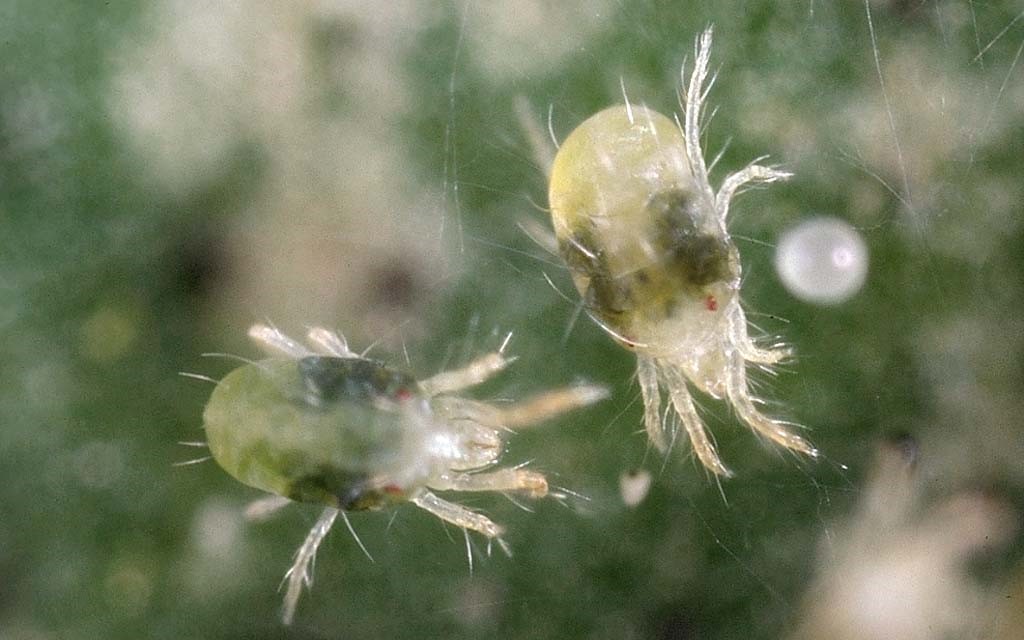

On a warm, dry summer day, some of my plants’ leaves had a sprinkling of light dots. Some were turning an unhealthy, ugly bronze color. The underside of the leaves revealed webbing, indicating that spider mites had infested the plants. Among the most common pests in the garden, spider mites can attack more than 200 plant species. Luckily, there are easy steps to take to control them.
Spider mites are not insects but members of the arachnid class, along with spiders and ticks. They have eight legs and two body parts. (Insects have six legs and three body parts.)
Spider mites make fine webbing on the underside of leaves, distinguishing them from all other types of mites and small insects, such as aphids and thrips, which can also infest leaf undersides. They spin webbing to protect themselves from natural enemies and the weather.
Then they suck cell contents from leaves, damaging plants, including roses, fruit trees, vegetables, berries, vines, azaleas, dahlias, tomatoes, houseplants and ornamental plants.
These pests increase during the dry months of June to September. They prefer hot, dusty conditions and are usually first found on trees or plants adjacent to dusty roadways or garden edges. Plants suffering from a lack of water are more vulnerable.
To the naked eye, spider mites look like slight moving dots. I held a piece of white paper below an affected plant and shook a few leaves so some spider mites would drop off. They scooted around rapidly. They are tiny — less than 1/20-inch long.
Spider mites live in colonies; a single colony may contain hundreds of pests. Populations can multiply to huge numbers quickly; a generation can be completed in less than a week under the right conditions: hot weather, low humidity and dust and dirt on leaf surfaces.
While a small number of mites isn’t usually a problem, high populations can damage plants, especially herbaceous ones. At first, the damage shows up as a stippling of light dots. As their feeding continues, the leaves turn yellowish or reddish and drop off. Damage may increase if plants are under water stress.
On ornamentals, spider mites may even kill plants when their populations become very high. Loss of leaves on fruit trees may impact next year’s crop.
For annual vegetable crops, the loss of leaves can significantly affect yield and lead to sunburning. Spider mites can cause direct damage to sugar peas and beans, where pods are attacked.
To control spider mites, start by keeping your plants adequately irrigated. Water-stressed plants are most likely to become good homes for spider mites.
Spider mites have many natural enemies that limit their numbers in many landscapes and gardens, especially when undisturbed by pesticide sprays. One of the most helpful is predatory mites. Other insects are also good predators: predatory thrips, lacewings and minute pirate bugs.
Cultural practices can also significantly impact spider mites. Dusty conditions often lead to outbreaks. Apply water to pathways and other dusty areas at regular intervals. Midseason washing of trees and vines with water to remove dust may also help prevent serious late-season mite infestations. Forceful spraying of plants with water should reduce spider mite numbers adequately, especially on the underside of leaves. Remove fallen leaves, branches, fruit and weeds that may serve as a host for spider mites.
If more control is necessary, use an insecticidal soap or oil in your spray, such as neem, canola or cottonseed oils. Be sure to test the product on one or two plants in advance to ensure it won’t damage them. If you have a spider mite infestation now, prune out damaged portions of plants and those with significant webbing.
As the seasons change, with cooler temperatures and rain, spider mite populations should decline rapidly — until next summer. Then, take preventive measures early to keep spider mites at a manageable level.
Sponsored by UC Cooperative Extension, the University of California Marin Master Gardeners provides science- and research-based information for Marin home gardeners. Email questions to helpdesk@marinmg.org. Attach photos for inquiries about plant pests or diseases. Please call 415-473-4910 to see when a master gardener will be at the office or drop off samples 24/7 in the sample box outside the office. To attend a gardening workshop or subscribe to Leaflet, a free quarterly e-newsletter, go to marinmg.ucanr.edu.


 PREVIOUS ARTICLE
PREVIOUS ARTICLE
